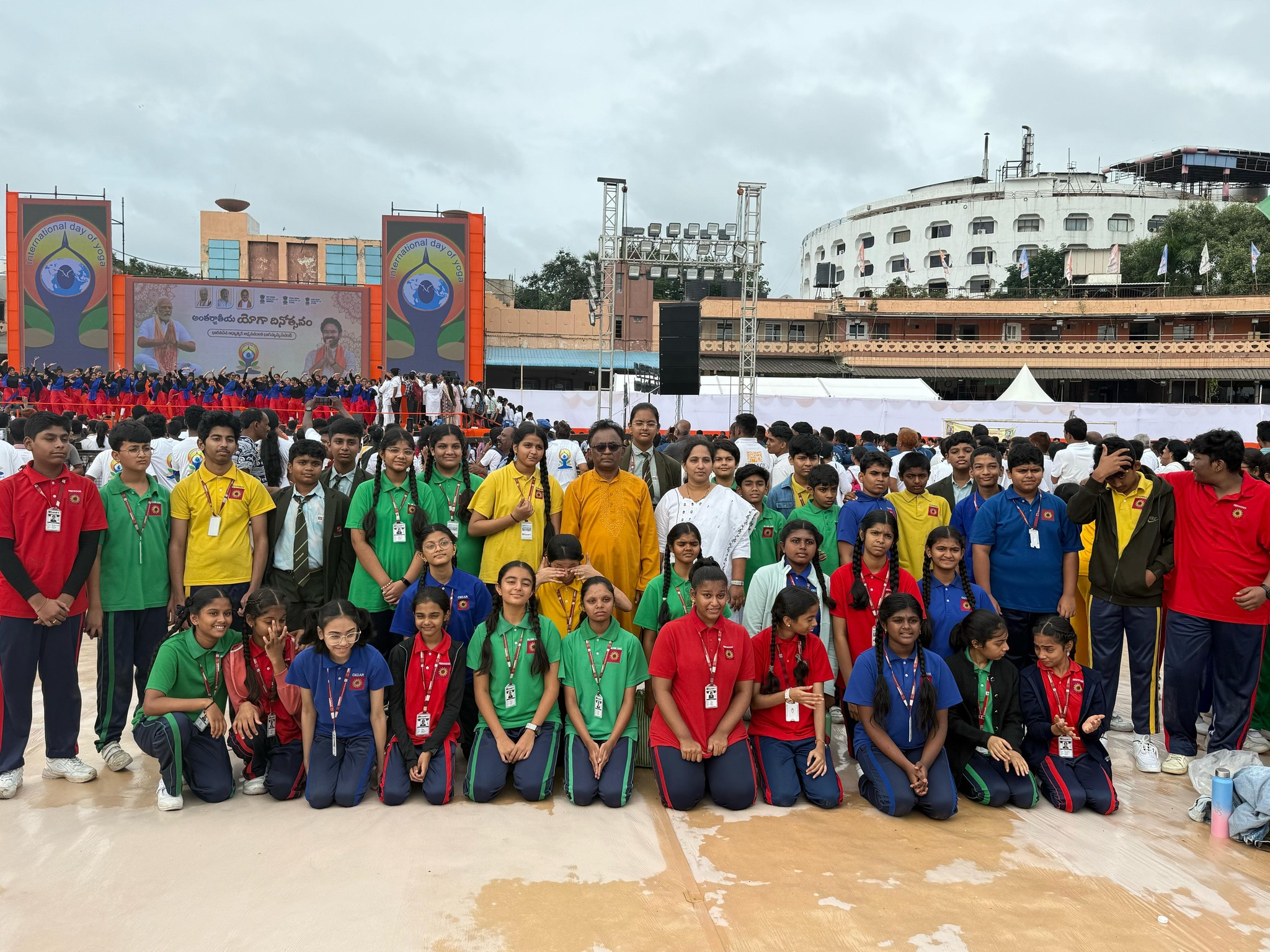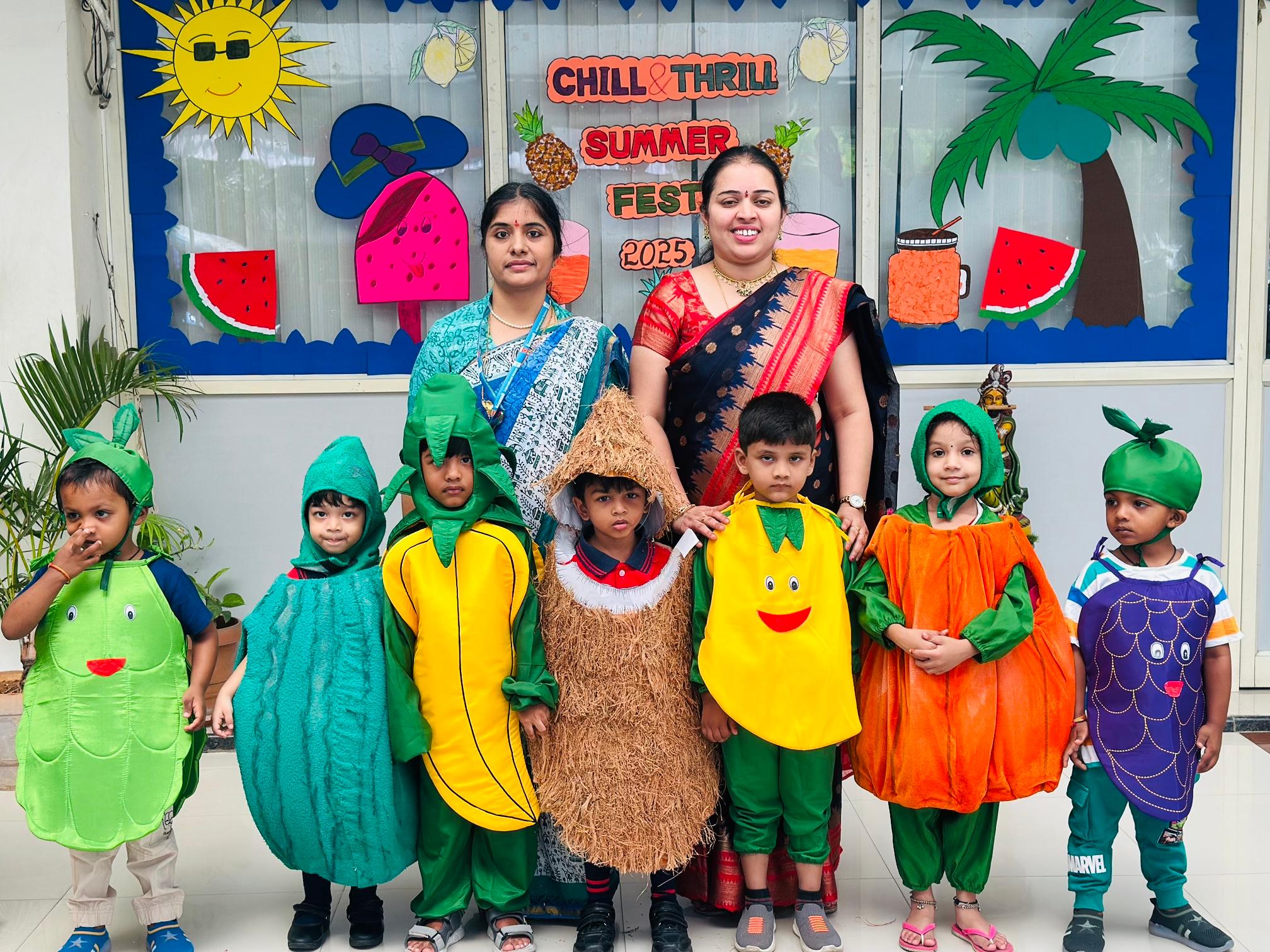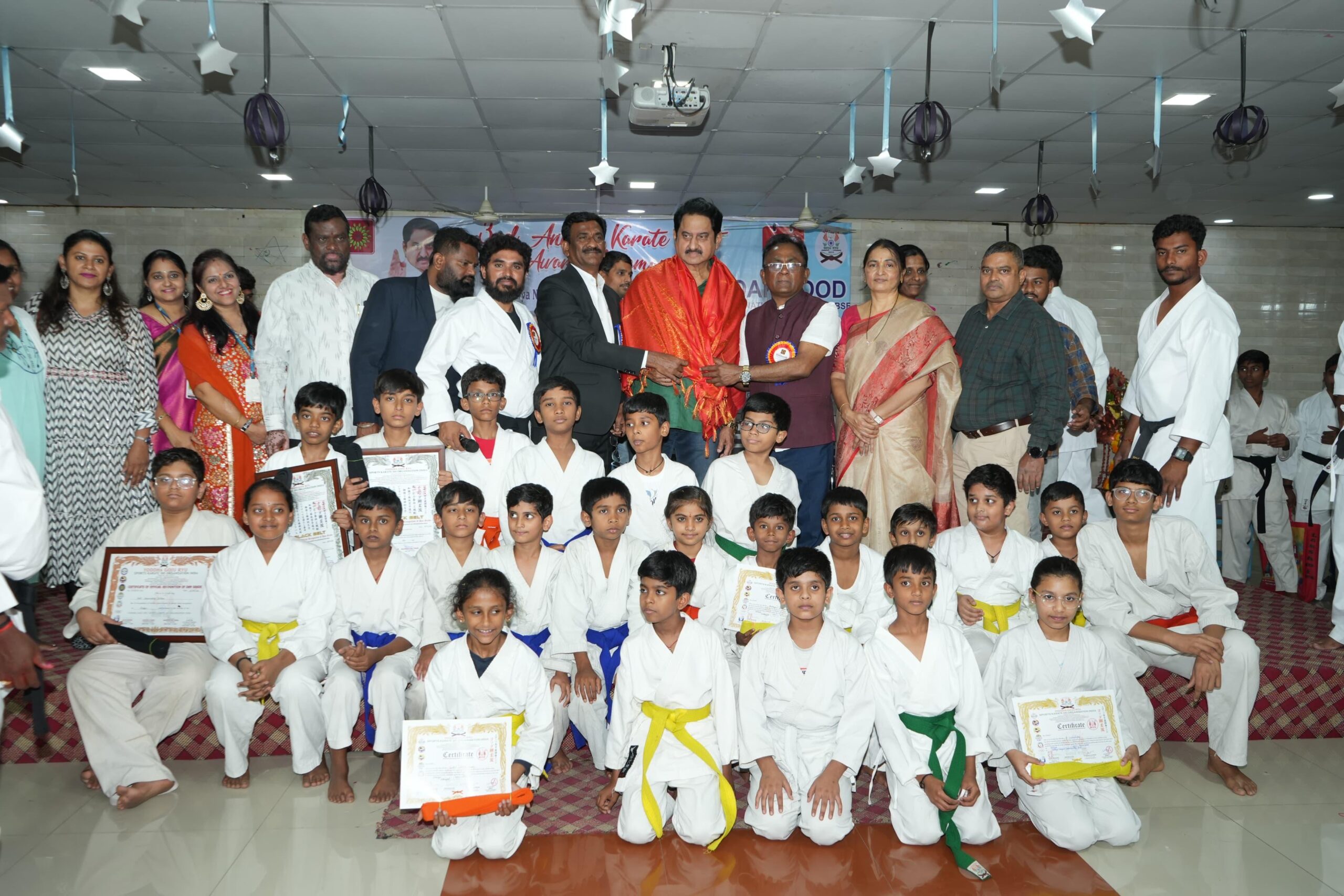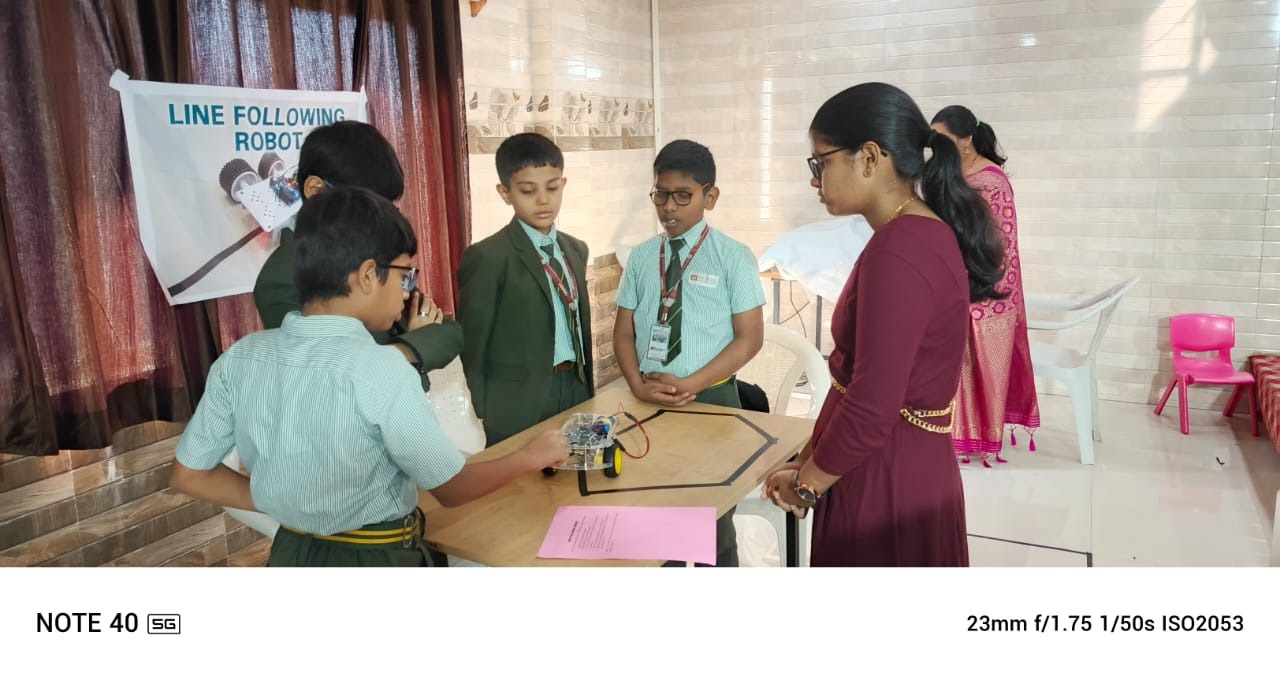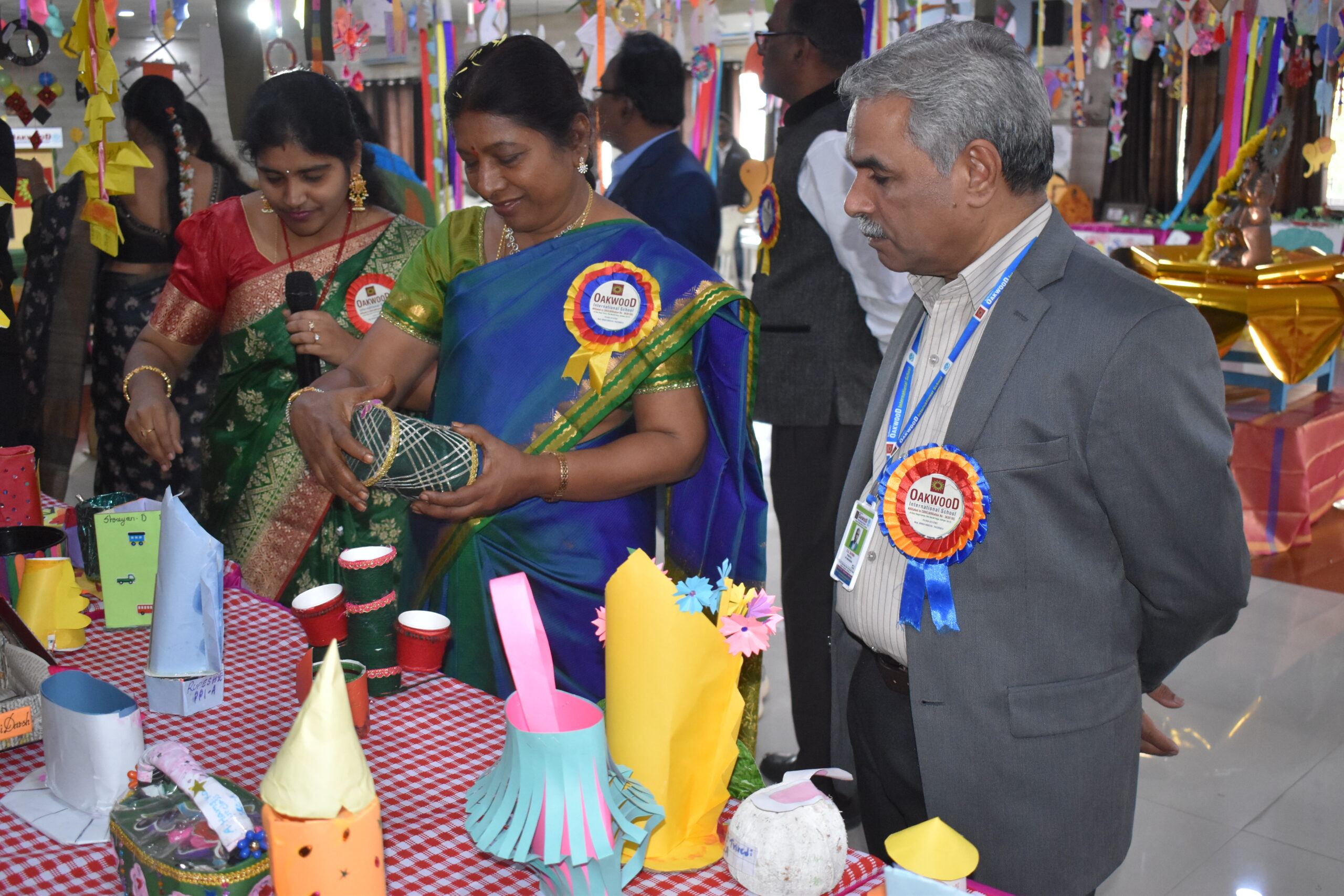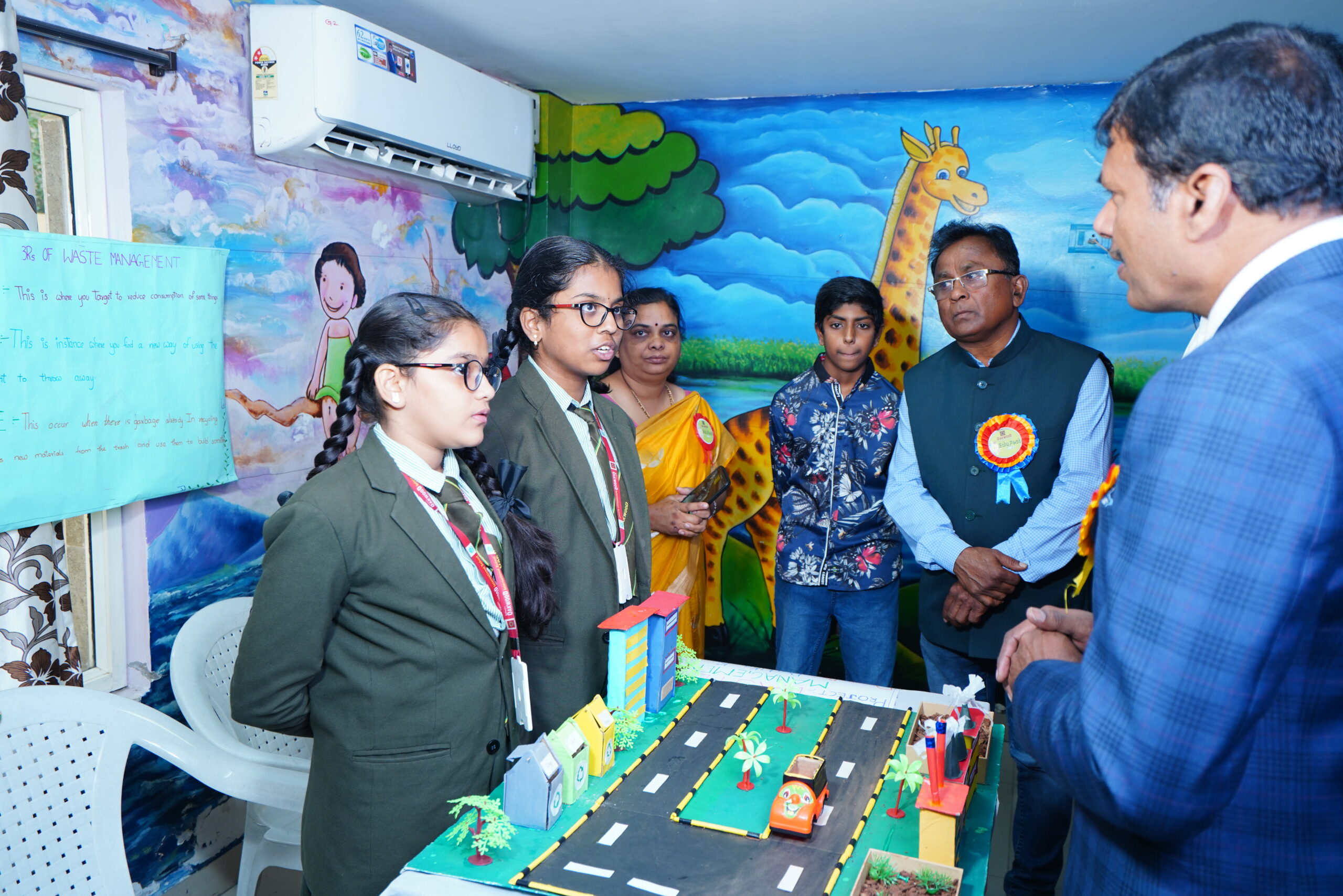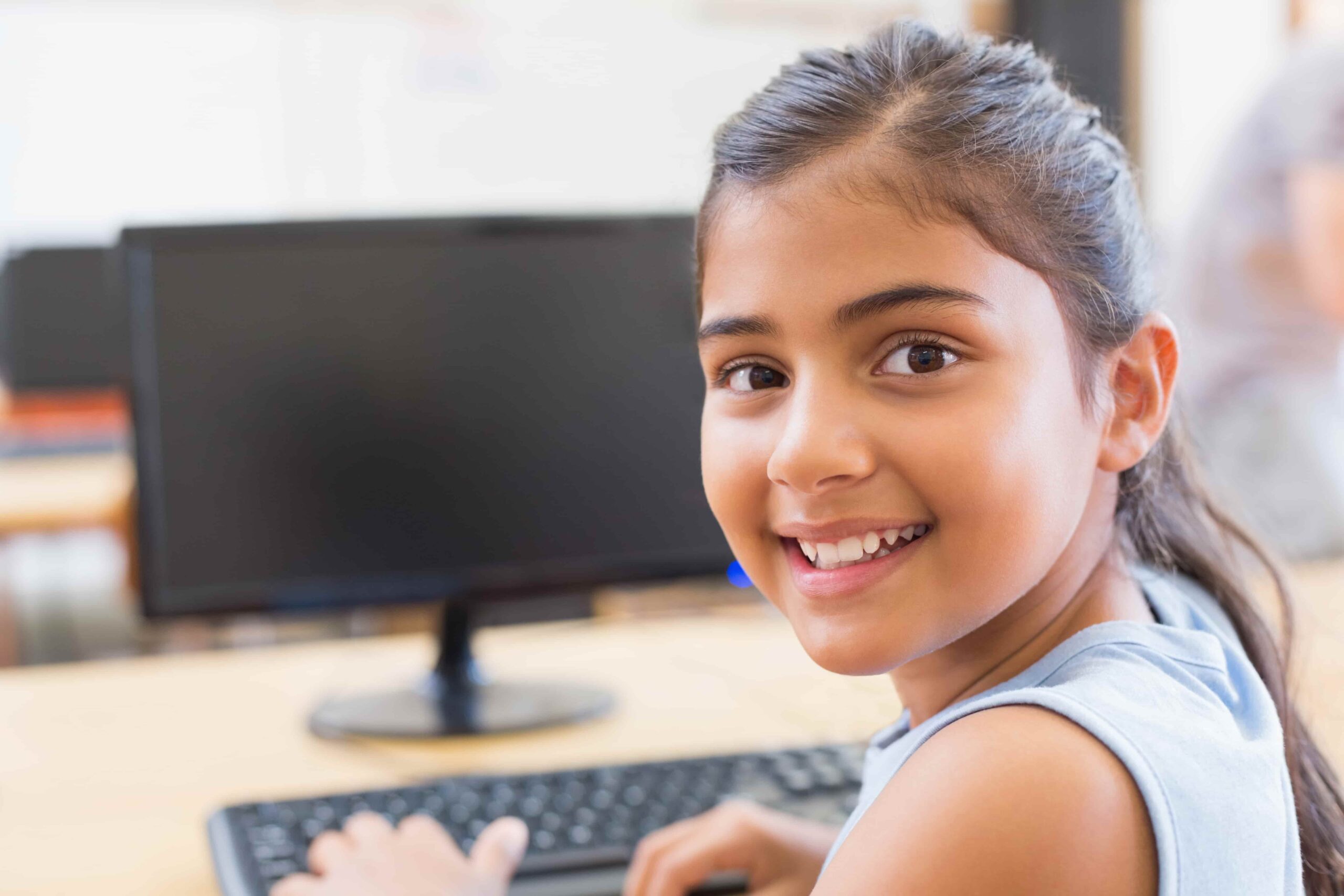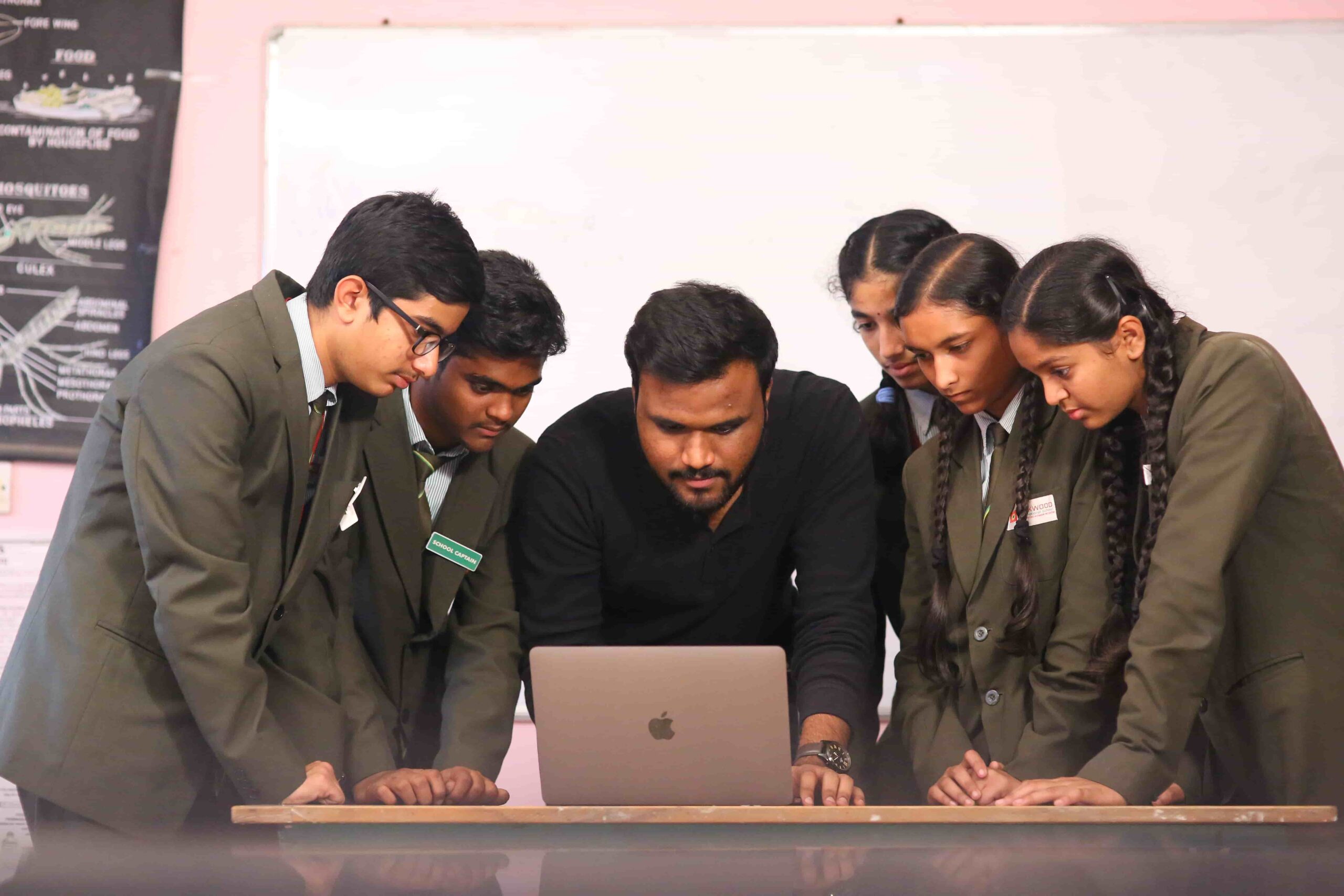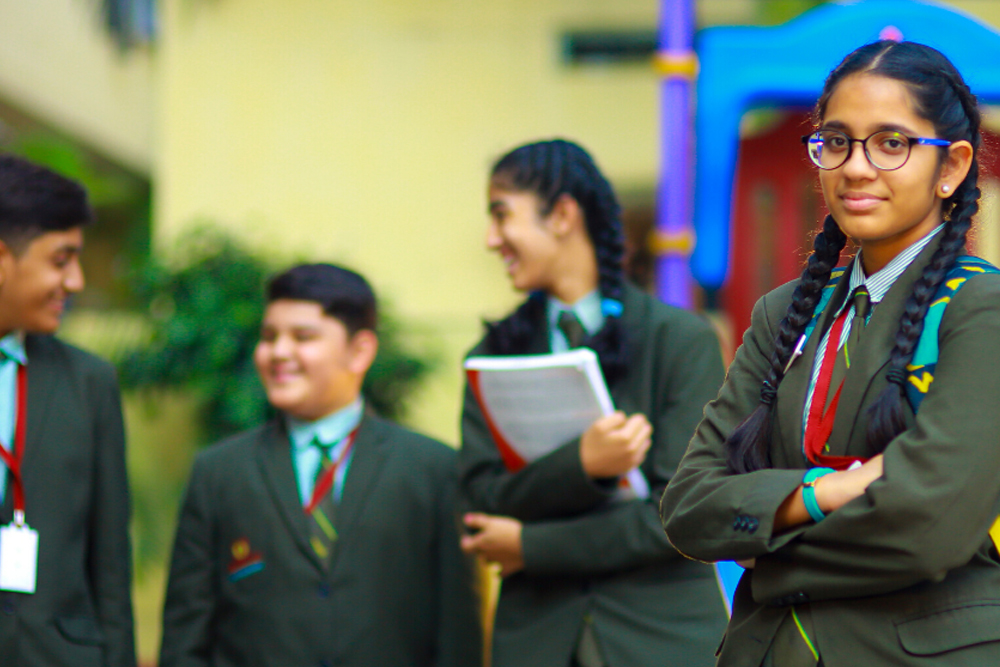Latest Posts
June 22, 2025UncategorizedAt Oakwood International School, we believe in nurturing not only academic excellence but also physical and mental well-being. In keeping with this holistic approach to education, we proudly celebrated International Yoga Day 2025 with a series of enriching and engaging yoga activities across the school.
From our youngest learners to our senior students, the Oakwood campus was filled with energy, calm, and harmony as children performed various yoga asanas under the guidance of trained instructors. The sessions focused on breathing techniques, mindfulness, and flexibility, reminding us all of the timeless benefits yoga brings to our daily lives.
Adding to the pride of the day, Oakwood Team, led by our Vice-Chairman Lion Dr. Gopal Reddy, took part in the prestigious 24-hour countdown event hosted at the LB Stadium in Hyderabad. This grand initiative, organized under the aegis of the Union Coal and Steel Ministries, served as a nationwide reminder of the significance of yoga in promoting health, peace, and unity.
Dr. Gopal Reddy’s presence at the event reflects Oakwood’s commitment to national initiatives that foster well-being and character development. His involvement was not only a moment of pride for the Oakwood community but also a powerful message to our students about the importance of embracing wellness practices at every stage of life.
🧘 Highlights from Our Celebration:
Guided yoga sessions for students across all grades
Awareness talks on the benefits of yoga for physical and mental health
Live streaming of national Yoga Day events in classrooms
Special art and poster activities for Grade IV and V students themed around yoga and mindfulness
Participation in the national countdown event at LB Stadium, Hyderabad
As we continue our journey of holistic education, events like International Yoga Day remind us that a healthy body and a peaceful mind are essential to unlocking the full potential of every learner.
Happy International Yoga Day from all of us at Oakwood! [...]
May 10, 2025UncategorizedJust a couple of days before the much-awaited summer vacation, Oakwood International School came alive with vibrant energy, laughter, and the irresistible aroma of delicious food during the much-loved “Chill & Thrill🍉” event. Designed as a joyful send-off to mark the end of the academic year, this event was all about celebrating the journey of learning, friendship, and growth that students experienced throughout the year.
The central idea behind “Chill & Thrill🍉 was simple yet heartwarming — to create a festive atmosphere where children could indulge in a delightful food fest filled with snacks, fruits, and sweet treats, all lovingly prepared and presented. More than just a fun day, it was a showcase of teamwork and hospitality, as students took the lead in serving and sharing with their peers, embodying the values of kindness, responsibility, and community spirit.
From colorful fruit platters to creative snack displays, every corner of the event venue buzzed with excitement. Students, teachers, and staff participated enthusiastically, turning the school grounds into a mini carnival of flavors and smiles. There were laughter-filled games, cheerful music, and plenty of moments worth capturing — a true celebration of the Oakwood spirit.
““Chill & Thrill🍉” wasn’t just a food fest — it was a symbolic pause, a way for everyone to come together and reflect on the wonderful memories made during the academic year. It filled the air with anticipation and positivity, giving students a memorable send-off before they embarked on their summer break.
As the event came to a close, one thing was certain — the joy, energy, and togetherness felt that day would linger in everyone’s hearts, reminding them that learning at Oakwood goes far beyond books. It’s about building a community, celebrating milestones, and of course, having a little fun along the way!
Here’s to a thrilling year ahead and a chilled-out summer full of new adventures! [...]
March 23, 2025UncategorizedOakwood International School (CBSE) in Kothapet, Hyderabad, recently hosted its much-anticipated Annual Karate Belt Award Ceremony—a vibrant celebration of talent, dedication, and the indomitable spirit of its young martial artists. The event shone a spotlight on the students’ hard-earned achievements and underscored the school’s commitment to fostering well-rounded individuals.
The ceremony reached a high point with the presence of celebrated actor Suman, who graced the occasion as the chief guest. Adding a touch of star power, Suman personally handed out awards to every student who had competed in the karate competition. The young karatekas, brimming with energy and pride, showcased their skills with confidence, earning applause and admiration for their perseverance.
The event was graced by renowned cine actor Suman, who served as the chief guest. His presence added a special touch to the occasion as he personally presented the awards to all the students who participated in the karate competition. The students, filled with enthusiasm and determination, showcased their skills and received well-deserved recognition for their hard work.
In a heartfelt address, Suman inspired the students to pursue their martial arts journey with unwavering discipline and passion. “Keep pushing your boundaries,” he urged, his words igniting a spark of motivation among the budding athletes. His encouragement left a lasting impression, fueling their aspirations to soar to new heights.
Suman encouraged the students to continue their journey in martial arts with discipline, perseverance, and a strong spirit. His inspiring words motivated the young karatekas to aim higher and push their limits.
For Oakwood International School, the event was a testament to its dedication to promoting physical fitness, self-discipline, and sportsmanship. The ceremony buzzed with pride as parents, teachers, and school management came together to cheer on the participants. Their collective appreciation extended to Suman, whose presence elevated the day into something truly memorable.
The ceremony was a proud moment for Oakwood International School, highlighting its commitment to promoting physical fitness, self-discipline, and sportsmanship among students.
The evening wrapped up on an uplifting note, with students beaming with pride and determination. The Annual Karate Belt Award Ceremony not only honored their achievements but also set the stage for even greater accomplishments in their martial arts journey. At Oakwood, the future of these young karatekas looks brighter than ever. [...]
March 5, 2025UncategorizedEmpowering Tomorrow’s Leaders: Celebrating International Women’s Day at Oakwood International School CBSE, Kothapet, Hyderabad
At Oakwood International School CBSE in Kothapet, Hyderabad, we believe that education is the cornerstone of progress—a force that ignites curiosity, dismantles barriers, and empowers every child to shape a brighter future. This International Women’s Day, we didn’t just celebrate the remarkable achievements of women across the globe; we sowed the seeds of equality, ambition, and leadership in our students. As one of the premier CBSE schools in the LB Nagar-Kothapet region, Oakwood stands tall as a beacon of holistic education, nurturing young minds to become compassionate, confident, and capable leaders of tomorrow.
A Day Brimming with Inspiration and Insight
Our International Women’s Day celebration was a vibrant tapestry of learning, creativity, and reflection. The campus buzzed with energy as students immersed themselves in activities designed to honor women’s contributions and spark meaningful conversations. From captivating storytelling sessions that brought to life the legacies of trailblazing women—scientists, artists, and changemakers—to spirited debates on gender equality, our students explored ideas that transcended the classroom. Role-plays saw them step into the shoes of iconic figures, while essay competitions and an art exhibition showcased their creativity and deep understanding of women’s impact on society. Each activity was a testament to their growing awareness and commitment to a more equitable world.
Education as Empowerment: The Oakwood Way
At Oakwood International School, empowerment isn’t just a buzzword—it’s woven into the fabric of our CBSE curriculum and daily life. Our dedicated faculty fosters an environment where mutual respect and equality thrive, encouraging students to see beyond stereotypes and embrace diversity. Through specialized programs in leadership development, life skills, and career counseling, we equip our students with the tools to break barriers and chase their aspirations. Whether it’s a science project, a debate, or a community initiative, we ensure every child discovers their potential and learns to lead with purpose.
Why Oakwood Shines in Kothapet
Nestled in the heart of Kothapet, Hyderabad, Oakwood International School CBSE stands out for its unwavering commitment to excellence. Our holistic approach blends academic rigor with character development, innovation, and social responsibility. Beyond stellar CBSE results, we pride ourselves on a rich array of extracurricular opportunities—from sports and performing arts to robotics and environmental clubs—that nurture well-rounded individuals. Our state-of-the-art facilities, passionate educators, and focus on global citizenship make us a top choice for parents seeking an education that prepares their children for the challenges and opportunities of the 21st century.
A Legacy of Inclusion and Impact
For us, International Women’s Day is more than a single celebration—it’s a reflection of our year-round mission to build an inclusive community where every student thrives. As we continue to uphold our legacy of excellence in Kothapet, Hyderabad, we remain steadfast in our goal: to raise a generation of thinkers, doers, and leaders who champion equality and compassion in all they do.
Here’s to the future—where every Oakwood student, regardless of gender, steps boldly into the world, ready to lead, inspire, and transform. Together, we’re not just celebrating women today; we’re shaping a tomorrow where every voice matters. [...]
February 11, 2025UncategorizedOur school recently hosted an inspiring Robotics Expo, where students showcased their creativity and technical skills through 16 unique projects. The event was a vibrant display of young minds solving real-world problems using robotics and automation. Parents, teachers, and visitors were amazed by the students’ ability to design, build, and explain their projects with confidence and enthusiasm.
Innovative Projects on Display
The expo featured a wide range of projects, each addressing different challenges using robotics and automation. Some of the standout projects included:
🔹 Smart Parking System – A solution designed to optimize parking space and reduce congestion.🔹 Fire Safety System – A robot capable of detecting and responding to potential fire hazards, enhancing safety measures.🔹 Wall-Following Robot – A robot that autonomously follows walls, showcasing advanced navigation and sensor integration.🔹 Automated Waste Segregator – A system that helps sort waste efficiently, promoting environmental sustainability.🔹 Traffic Management System – A project aimed at improving traffic flow and reducing road congestion using smart sensors.
Each project reflected the students’ deep understanding of robotics, programming, and engineering concepts. Visitors were impressed by the level of detail and problem-solving approaches used by the participants.
Students Take the Lead
One of the highlights of the expo was how students confidently presented their projects, explaining the working principles, technology used, and real-life applications. They demonstrated their coding skills, circuit design expertise, and mechanical engineering knowledge, proving that hands-on learning is one of the best ways to grasp complex concepts.
Parents and guests were highly engaged, asking insightful questions and appreciating the effort put in by the students. Teachers and mentors played a vital role in guiding them throughout their journey, but the students took full ownership of their projects, making the event even more rewarding.
Some standout projects included a Smart Parking System that optimizes space, a Fire Safety System designed to detect and respond to hazards, and a Wall-Following Robot that navigates its surroundings autonomously. Each project demonstrated the students’ dedication to learning and applying robotics and automation concepts.
Parents were thrilled to see the students explain their work with confidence, showcasing their knowledge and passion for technology. The Robotics Expo was not just an exhibition—it was a celebration of innovation and a glimpse into the future of engineering! 🚀🤖
A Step Towards the Future
The Robotics Expo was more than just a showcase—it was a glimpse into the future. As technology continues to shape our world, events like these encourage students to think critically, innovate, and prepare for careers in STEM (Science, Technology, Engineering, and Mathematics) fields.
We are incredibly proud of our young innovators and look forward to seeing them push the boundaries of technology even further. A big thank you to all the students, teachers, and parents who made this event a grand success!
🚀 Stay tuned for more exciting STEM initiatives at our school! 🤖 [...]
January 21, 2025Oakwood EventsOakwood International School was abuzz with energy and enthusiasm as it hosted its long-awaited Annual Day, Tarang 2024. After a hiatus of several years, the event made a grand comeback, leaving a lasting impression on everyone present. The vibrant celebrations were marked by cultural performances, inspiring speeches, and heartfelt moments that showcased the talents and spirit of the Oakwood family.
Guests of Honour
The event was graced by distinguished personalities whose presence elevated the evening:
Prof. Kodandaram, Member of the Telangana Legislative Council, served as the Chief Guest.
Kundooru Jayveer Reddy, MLA of Nagarjuna Sagar, joined as a Special Guest.
Dr. K. Ramesh, Senior Regional Director of IGNOU, was the Guest of Honour.
D. Muralidhar, a renowned counseling psychologist, coach, and trainer, added further prestige to the occasion.
A Day Full of Cultural Brilliance
The festivities commenced with a Saraswati Pooja, followed by a mesmerizing sequence of performances. The program unfolded in two parts: an afternoon segment filled with delightful performances from the younger students and an evening filled with spectacular showcases by senior students and dignitary addresses.
Highlights
The stage came alive with vibrant performances from the youngest talents:
A cheerful Welcome Dance by Ms. Priyanka set a joyful tone.
Mickey Mouse Dance by Nursery & PP I students brought smiles all around.
Energetic routines like Rock and Roll by PP II and Back to School by Grade I A filled the air with excitement.
Nostalgic themes like Jungle Book by Grade I B and a charming Couple Dance by Grade II A delighted the audience.
A breathtaking Earth Dance by Grade II B left everyone inspired.
Evening Splendor
The evening session began at 6 PM with a Welcome Address by Mrs. Nirupama, followed by a ceremonial Lighting of the Lamp accompanied by a prayer song. The highlights included:
A stunning Welcome Dance – Kantara, which captivated the audience.
Heartwarming speeches, including the Principal’s Report and addresses by the esteemed guests.
The much-anticipated Release of the School Magazine and Felicitation of Dignitaries.
Captivating Performances
The students’ creative expressions took center stage with a variety of performances:
Telangana Folk Dance (Grade III B) and Kerala Dance (Grade III A) celebrated the rich cultural heritage of India.
A powerful Karate demonstration (Grades I-X) showcased discipline and skill.
A thought-provoking Skit by high school students resonated with social messages.
Dances like Rajasthani Pot Dance (Grades VI-IX), Kohli Dance (Grades IV & V Girls), and Bhangra (Grades IV-IX Boys) added a kaleidoscope of colors and energy.
Unforgettable Moments
Other highlights included:
An artistic Pyramid Formation (Grades III-IX), which drew applause for its precision and creativity.
Musical Concerts (Grades VI-VIII) and a series of vibrant special dances by Grade X boys and girls.
Patriotic performances and unique renditions like Avatar, Kavadi, and Krishna Dance added emotional depth to the event.
Celebrating Excellence
The Award and Certificate Distribution Ceremony was a proud moment for the achievers and their families. It recognized the dedication and hard work of students across academics, sports, and cultural activities.
A Grand Finale
The evening concluded with a grand National Anthem, leaving everyone with a sense of pride and unity. The resounding applause and cheerful faces were a testament to the success of Tarang 2024.
A New Beginning
Tarang 2024 was not just an event but a celebration of resilience, talent, and community spirit. It marked the beginning of a new chapter for Oakwood International School, promising even brighter and more memorable events in the years to come.
VIEW ANNUAL DAY IMAGES [...]
December 10, 2022UncategorizedVincent Van Gogh once said. ‘‘If you hear a voice within you say you cannot paint then by all means paint, and that voice will be silent.” This beautiful thought resonates perfectly with the Behance Art Expo organised by Oakwood international school on 10-12-2022.The tiny tots of this school surely seem to have embarked on a journey to hone their latent creative abilities.
From Nature to everyday life, no concept seemed beyond the creative pursuits of these budding artists who in a splash of colours have created a visual world which came alive that day.
The event stood as a platform for young minds to transcend the boundaries of their inherent artistic potential. From bright hues from crayons and colour pencils and distinct palettes of acrylic paint, colour seemed to be everywhere around as the exhibition relied more on the artistic pursuits of the young minds without tethering them to restricted themes. The pre-primary children used brushes, balloons, bubble paper, handprints and embellished their paintings with a riot of colours. The primary children created an intriguing array of paintings depicting landscapes, seasons and nature at their scenic best. Unusual mediums like sand art and mount boards found an equal standing with the more conventionally used canvas and art paper. In the words of art, it is delightful to say that the exhibition was aptly called Behance as it enhances the hidden potential of students with artful and heartful creations of young minds.
Our special guest, Smt Jalaja Lingala, a stalwart in the field of education graced the occasion and stood enthralled with the volumes of art expressed on various mediums by tiny hands with vast realms of imagination.
The parents and guests who visited the exhibition were seen admiring the masterpieces of the children and everyone present had a good time.
The canvas of minds of these little ones is beyond the boundaries of our understanding.it astonishes us to see these wonderful creations far-fetched from our everyday mundane lives.
Behance Art Expo is like a breath of fresh air that touches us gently and inspires us deeply. A child is the best artist on this world with boundless imagination and tons of curiosity.
A world full of colours, a rainbow of flowers, birds with wings of hope and a universe of colourful dreams is all possible from the brush of a child!!!!! [...]
December 3, 2022UncategorizedIn today’s era, education is beyond the confines of the classroom. It is now more about the holistic all-round development of the children. And this is where Oakwood International School is leaving no stone unturned to help students to explore their abilities and is providing them different opportunities to showcase their skills. These include exhibitions, special assemblies, presentations and annual celebrations.
19th November 2022 was a memorable and cheerful day for all the students of Oakwood International School as we conducted our annual EDUFEST modelled on the innovative thoughts and concepts of our students. An EDUFEST is a wonderful opportunity that engages students in widening their horizons by applying their learning into practical models. It develops in them the curiosity to learn more in an interesting and exponential way.
The event was graced by the inspiring presences of our Chief Guest- Dr. Ramesh Kandukuri, Deputy Director, IGNOU whose vast experience in the field of education has set a worthy example for our students to look up to.
Inspired, encouraged and motivated budding Students of Oakwood performed different experiments with great enthusiasm and excitement. They also displayed the wonderful depth and beauty of the Telugu, Hindi and English languages. It was so wonderful to watch our own little Einstein’s and Edison’s come up with beautiful models in Science and Maths to demonstrate what they have learnt .The projects were age appropriate and explained in striking detail by all the participants. The students were eager to answer all the questions of the visitors. The projects were well designed and depicted the concepts beautifully. The language departments also articulated the beauty of our languages and helped the students understand the importance of languages in our educational journey.
The parents were also glad to be provided an opportunity to attend the EDUFEST. It was a crowded affair to see many parents drop by to visit the fest and encourage children. The students were equally zealous to explain the concept of their project /experiment to everyone present. The esteemed Chief Guest for the day, Dr. Ramesh Kandukuri, Deputy Director, IGNOU was delighted and overwhelmed by each child’s performance. He appreciated the efforts by the teachers and academic staff involved for the smooth and successful conduct of the event. The EDUFEST event wrapped up only in the evening with the children going home joyful and satisfied even though they all looked exhausted.
This exhibition made students more confident, creative, future-ready, and learners for life. It also took the parents and visitors, a few decades into their childhood filled with memories of the classrooms with the sound of chalk on the board, the fragrance of books, the voices of our teachers and friends, the experiments which we all did as children and most importantly the best years of life-The School Days. [...]
February 18, 2022UncategorizedSwami Vivekananda explained education as the manifestation of knowledge already existing in the man. Sri swamy clarified the concept by giving a beautiful example of the generation of a sapling from the seed of a plant.
When a small seed is planted in the soil and watered, the sapling comes out of the seed. It takes water from the soil, life force from the sun and grows into a plant. Subsequently it grows into a huge tree. The growth of a plant depends on the nature of the soil and availability of water and sun light. The basic contents for the growth of the plant are embedded in the seed.
Similarly in the process of education the parents and teachers have to create the required environment for the child to grow naturally. For this reason, the term facilitator is more appropriate in the educational institutions.
The role of a facilitator is very important in the right way of educating the children in the school system. Hence the facilitators should understand the importance of their role in the process of education.
Sri Aurobindo Ghose a great philosopher suggested various methods of teaching like observation,self discovery activity method teaching with love and sympathy , learning by doing, discussion method ,learning by self experience. Education is learning together. [...]
March 1, 2021UncategorizedOnline education is the new normal for both teachers and students. It took a while for both parties to adjust to the new way of academic life. The formal atmosphere, discipline and the camaraderie of classmates were missing here. Struggle with technology and gadgets was another challenge they had overcome. Holding the attention of the wavering young minds was the biggest challenge for teachers and students themselves. But pandemic left them with no choice but to create innovative means to achieve a productive outcome. And as the teachers and the taught waded through, parents continued to be the reliable facilitators in this new realm too.
Be it international schools, public schools or government institutions, the inconvenience was palpable initially. With time, school management, faculty and students picked up the threads and ran the marathon, hurdling over every challenge. They found new ways to connect strongly and achieve goals. Eventually they started surfing over online education without much turbulence. The tech-savvy nature of the new generation helped a lot. But the traditional methods of learning and testing wouldn’t leave your system so easily. While they torqued through the new education techniques through the milestone year, but the examination bit remained a challenge.
What the students learnt online right through the year, will they be able to analyse and implement it as solutions in an offline atmosphere? The online culture might have impacted the earnestness to write an offline examination. The assurance of classroom education gives a certain confidence to the student, who are used to it since many years. Physically attending a classroom goes a long way in building the foundation stronger. The presence of a teacher, their role model behaviour, values that stand by…all of it does have an effect on the students, their education, personality and more. Hence it is important to revert to the traditional way of teaching and learning, as going to school is not just about academics and marks but about complete personality development of the next generation. Hence the hope is truly high during this critical phase, which is also admissions season for the next academic year, which hopefully returns to the traditional ways of conducting academics. [...]
February 17, 2021UncategorizedCan you imagine life without technology?
Well, no one can. When the Covid-19 pandemic brought life to a standstill, technology was the panacea that saw us through. It provided the impetus to work, study, and get necessities done without compromising safety.
Empowering the next generation
Children are our future. To nurture, empower and prepare the next generation for the uncertain future, we need to incorporate innovation and technology into our current education system. And the pandemic has taught us the same. Today it doesn’t matter which part of the world you are in. You can access world-class education right from the safety of your home. Online education has empowered children to study at the best of international schools. All they need is a good computer with a steady internet connection.
Going beyond textbooks
Though several theories propagate the limitations of online education, practical experience has taught us differently. Digital learning has done wonders in upgrading the learning experience of children. Children now have the flexibility and freedom to pursue their interests like never before. Certified teachers go beyond textbooks to teach empathy, cross-cultural communication, social etiquette and much more. Online education has brought the next generation closer to their families. Children are now more mindful, observing and learning values from elders at home and some are even participating in everyday chores.
Catalysts for a bright future
Educational institutions including international schools and virtual universities invest a lot in making classes interactive, engaging and gamified. They foster holistic development by adopting innovative teaching methods. Teachers impart personalized experiential learning to ignite creativity and confidence among the wards. Children are equipped to manage cross border interaction and job opportunities in the future. They also imbibe new life skills that foster smart work and time management.
Humane and tech-savvy
Schools lay the foundation for the future by nurturing and empowering children through education. While they reiterate and enrich the human values in children on one end, they help them handle technology powered lifeskills for a bright future on the other end. [...]
February 10, 2021UncategorizedDid you know that kids opting active school travel (AST) or in simple terms walk or cycle to school reportedly show higher levels of happiness, enhanced mental health, and experience much lower levels of stress throughout the day? Research also shows that kids commuting to school on foot or on bicycle have better immunity, attention spans, traffic sense and to top it all – exhibit better academic performance.
Ah, the perks of sending your child to a school nearby! Check out a few more benefits a school in your surroundings can offer:
Better use of the child’s free time
Children can reach home early, relax and restart their after-school activities like completing homework, nurturing a hobby, or simply helping at home.
Better use of school amenities
In-house sports facilities, school playground, after-school academic support and/or extra-curricular activities – your child can spend more time at school, utilising the amenities the school can offer and not worry about the commute back home.
Better management of your morning time
Gives you more time to prepare your child for school every morning; reduces the stress of waking up way early to prepare for school and worrying about your child’s tedious travel to school.
Better involvement in your child’s schooling
Chances of your involvement in your child’s schooling – showing up for Parent-Teacher meetings, school gatherings, managing adhoc pick-up and drop-offs, being available during emergencies, random quick check-ins with teachers etc., are higher when your child’s school is not far off from the place you stay.
Bearing in mind the need to encourage active living and immunity-enhancing habits in school-going children in post-COVID era, it is smart to select a school in your neighbourhood. This academic year, give your child the gift of active lifestyle and yourself the peace of mind a friendly neighbourhood school can offer. [...]
February 5, 2021UncategorizedDid you know that one in five people suffer from cancer globally?
Over the past six months, in India alone, 40% of cancer patients have deteriorated from a treatable stage 1 to a life-threatening stage 3.
While the entire world focused on the gruesome Covid-19 pandemic, silent killers such as cancer continue devouring their victims quietly. Lack of timely screening, diagnosis, and treatment took a heavy toll on cancer patients’ health during 2020.
As India’s future citizens, students need to understand, respect, and reach out to cancer victims in every way possible. They must stand up with empathy to bust the myths and destigmatize cancer.
Show compassion and care
Cancer patients endure emotional rollercoasters as they go through various treatments and procedures. They need love, compassion, and support from their family and friends to help them through this journey. As they are more vulnerable to the Covid-19 than the general populace, they rely on oncology professionals and their dear ones to get through this hard-hitting period.
Step up cancer literacy
The primary purpose of education is empathy, tolerance, and mindfulness. Students must understand cancer from the right perspective and reach out to cancer awareness as much as possible. But of course, with masks, sanitizers, and social distancing measures.
WHO affirms that 30 to 50% of cancer deaths can be prevented through lifestyle modifications. NGOs and health organizations partner with Government and International schools to spread awareness on the following Cancer prevention measures.
Stop tobacco usageMaintain a healthy weight and dietBe physically active Treat chronic infections and vaccinate regularly
The sooner we understand the more we can help to prevent, detect, and treat cancer at early stages.
Do your bit
If you meet people battling cancer, be kind to them. Encourage them to be happy, avoid risk factors, and adopt a healthy lifestyle. [...]

